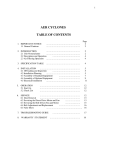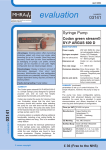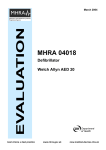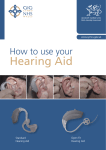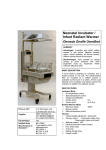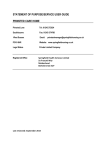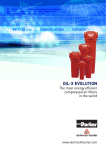Download good practice guide
Transcript
GOOD PRACTICE GUIDE 216 Energy saving in the filtration and drying of compressed air GOOD PRACTICE GUIDE 216 BEST PRACTICE PROGRAMME ENERGY SAVING IN THE FILTRATION AND DRYING OF COMPRESSED AIR This Guide is No. 216 in the Good Practice Guide series. It provides advice on practical ways of improving energy efficiency in the filtration and drying of compressed air. Case histories are also included, providing practical examples of how savings have been made. Prepared for the Department of the Environment, Transport and the Regions by: ETSU Harwell Didcot Oxfordshire OX11 0RA and Air Technology Ltd 6 & 7 Falcon Street Loughborough Leicestershire LE11 1EH ETSU also acknowledges the help of the following: Domnick Hunter, Denco Miller plc, Ultrafilter and Atlas Copo. © Crown copyright 1998 First published March 1998 LIST OF RELEVANT GOOD PRACTICE GUIDES 2. 3. 13. 18. 30. 31. 36. 37. 38. 42. 44. 48. 59. 69. 84. 85. 91. 126. 168. 169. 213. 214. 215. 217. ENERGY SAVINGS WITH ELECTRIC MOTORS AND DRIVES INTRODUCTION TO SMALL-SCALE COMBINED HEAT AND POWER HEAT RECOVERY FROM HIGH TEMPERATURE WASTE GAS STREAMS REDUCING ENERGY CONSUMPTION COSTS BY STEAM METERING ENERGY EFFICIENT OPERATION OF INDUSTRIAL BOILER PLANT COMPUTER AIDED MONITORING AND TARGETING FOR INDUSTRY COMMERCIAL REFRIGERATION PLANT: ENERGY EFFICIENT OPERATION AND MAINTENANCE COMMERCIAL REFRIGERATION PLANT: ENERGY EFFICIENT DESIGN COMMERCIAL REFRIGERATION PLANT: ENERGY EFFICIENT INSTALLATION INDUSTRIAL REFRIGERATION PLANT: ENERGY EFFICIENT OPERATION AND MAINTENANCE INDUSTRIAL REFRIGERATION PLANT: ENERGY EFFICIENT DESIGN REDUCING ELECTRICITY USE IN INJECTION MOULDING ENERGY EFFICIENT DESIGN AND OPERATION OF REFRIGERATION COMPRESSORS INVESTMENT APPRAISAL FOR INDUSTRIAL ENERGY EFFICIENCY MANAGING AND MOTIVATING STAFF TO SAVE ENERGY ENERGY MANAGEMENT TRAINING MONITORING AND TARGETING IN LARGE MANUFACTURING COMPANIES COMPRESSING AIR COSTS CUTTING YOUR ENERGY COSTS: A GUIDE FOR THE TEXTILE DYEING AND FINISHING INDUSTRY TOTAL QUALITY MANAGEMENT SUCCESSFUL PROJECT MANAGEMENT FOR ENERGY EFFICIENCY MAKING USE OF BUSINESS STANDARDS REDUCING ENERGY COSTS IN INDUSTRY WITH ADVANCED COMPUTING AND CONTROL CUTTING ENERGY LOSSES THROUGH EFFECTIVE MAINTENANCE (TOTALLY PRODUCTIVE OPERATIONS) Copies of these Guides may be obtained from: Energy Efficiency Enquiries Bureau ETSU Harwell Didcot Oxfordshire OX11 0RA Tel 01235 436747. Fax 01235 433066. E-mail [email protected] Overseas customers please remit £3 per copy (minimum of £6) with order to cover cost of packaging and posting. Please make cheques, drafts or money orders payable to ETSU. FOREWORD This Guide is part of a series produced by the Government under the Energy Efficiency Best Practice Programme. The aim of the programme is to advance and spread good practice in energy efficiency by providing independent, authoritative advice and information on good energy efficiency practices. Best Practice is a collaborative programme targeted towards energy users and decision makers in industry, the commercial and public sectors, and building sectors including housing. It comprises four inter-related elements identified by colour-coded strips for easy reference: — Energy Consumption Guides: (blue) energy consumption data to enable users to establish their relative energy efficiency performance; — Good Practice Guides: (red) and Case Studies: (mustard) independent information on proven energy-saving measures and techniques and what they are achieving; — New Practice projects: (light green) independent monitoring of new energy efficiency measures which do not yet enjoy a wide market; — Future Practice R&D support: (purple) help to develop tomorrow’s energy efficiency good practice measures. If you would like any further information on this document, or on the Energy Efficiency Best Practice Programme, please contact the Environment and Energy Helpline on 0800 585794. Alternatively, you may contact your local service deliverer – see contact details below. ENGLAND London Govt Office for London 6th Floor Riverwalk House 157-161 Millbank London SW1P 4RR Tel 020 7217 3435 East Midlands The Sustainable Development Team Govt Office for the East Midlands The Belgrave Centre Stanley Place Talbot Street Nottingham NG1 5GG Tel 0115 971 2476 North East Sustainability and Environment Team Govt Office for the North East Wellbar House Gallowgate Newcastle-upon-Tyne NE1 4TD Tel 0191 202 3614 NORTHERN IRELAND IRTU Scientific Services 17 Antrim Road Lisburn Co Antrim BT28 3AL Tel 028 9262 3000 North West Environment Team Govt Office for the North West Cunard Building Pier Head Water Street Liverpool L3 1QB Tel 0151 224 6401 South East Sustainable Development Team Govt Office for the South East Bridge House 1 Walnut Tree Close Guildford Surrey GU1 4GA Tel 01483 882532 East Sustainable Development Awareness Team Govt Office for the East of England Heron House 49-53 Goldington Road Bedford MK40 3LL Tel 01234 796194 SCOTLAND Energy Efficiency Office Enterprise and Lifelong Learning Dept 2nd Floor Meridian Court 5 Cadogan Street Glasgow G2 6AT Tel 0141 242 5835 South West Environment and Energy Management Team Govt Office for the South West The Pithay Bristol Avon BS1 2PB Tel 0117 900 1700 West Midlands Regional Sustainability Team 77 Paradise Circus Queensway Birmingham B1 2DT Tel 0121 212 5300 Yorkshire and the Humber Sustainable Development Unit Govt Office for Yorks and the Humber PO Box 213 City House New Station Street Leeds LS1 4US Tel 0113 283 6376 WALES Business and Environment Branch National Assembly for Wales Cathays Park Cardiff CF10 3NQ Tel 029 2082 5172 CONTENTS Section Page No. 1. INTRODUCTION 1 2. COMPRESSED AIR FILTRATION AND DRYING 2 3. HOW HIGH ARE YOUR TREATMENT COSTS? 4 CLASSIFICATION CLASSES How to Apply Classifications Typical Applications 5 5 5 SPECIFYING AIR TREATMENT EQUIPMENT 7 TREATMENT SYSTEMS After-cooling Air receivers Filtration Aughinish Alumina Ltd, Askeaton Compressor Pre-filtration Pre-filters General Purpose Filters High Efficiency Oil Removal Filters After-filters Dust Removal Filters Activated Carbon Filters Breathing Air Sterile Filters Point of Use Filters Drying Refrigerated Air Dryers (+3°C Dewpoint) Deliquescent Dryers (+10°C Dewpoint) Membrane Dryers (+4°C to -40°C Dewpoint) Desiccant Dryers (-20°C to -70°C Dewpoint) Barbican Centre, London Zeneca, Macclesfield Micron Mills Ltd, Orpington Sony Manufacturing Company, Bridgend Rosyth Royal Dockyard, Rosyth Vauxhall Motors, Ellesmere Port Condensate Collection Electronic Condensate Drain Traps (ECDTs) United Glass, Alloa Lubricators 8 8 8 8 11 11 11 11 11 12 12 12 12 12 13 13 14 15 15 16 19 19 20 20 21 21 21 22 22 23 APPENDIX - Useful addresses 24 4. 4.1 4.2 5. 6. 6.1 6.2 6.3 6.4 6.5 6.6 6.6.1 6.6.2 6.7 6.7.1 6.7.2 6.7.3 6.7.4 6.7.5 6.8 6.8.1 6.8.2 6.8.3 6.8.4 6.9 6.10 6.11 6.12 6.13 6.14 6.15 6.15.1 6.16 6.17 7. Section Page No. FIGURES Fig 1 Water removal each week from 500 l/sec of 7 bar(g) air 3 Fig 2 Treatment needed for a selection of common applications 9 Fig 3 Increased cost of generating compressed air to overcome pressure drops on a nominal 7.0 bar system 9 Fig 4 Dewpoint and the water holding content of air 13 Fig 5 A refrigerant air dryer 14 Fig 6 A deliquescent dryer 15 Fig 7 Operation of a membrane dryer 16 Fig 8 Operation of desiccant dryers 16 Fig 9 Dewpoint sensing control of heatless desiccant dryers 18 Fig 10 Dewpoint sensing control of heated desiccant dryers 18 Fig 11 Cutaway diagram of an electronic condensate drain trap 22 Table 1 Typical contamination levels for atmospheric and compressed air 2 Table 2 Typical additional costs for drying compressed air 4 Table 3 Air contamination classifications ISO 8573.1 5 Table 4 Typical application requirements 6 TABLES 1 ENERGY SAVING IN THE FILTRATION AND DRYING OF COMPRESSED AIR 1. INTRODUCTION The wide range of uses for compressed air means that there is a great variation in air quality requirements. The concentration of airborne contaminants during compression means that the compressed air direct from the compressor package can rarely be used without some form of treatment. Fortunately there is a wide range of equipment available which can satisfy the most demanding of applications. The careful selection, installation and maintenance of treatment equipment can help reduce the associated energy costs of treating air, namely due to direct energy costs for running equipment, the extra generation cost needed to overcome additional pressure drops, or the cost of purging air. This Good Practice Guide (GPG) starts by describing the contaminants that may be present in air, and then gives guidance on selecting the level of treatment appropriate to the application. It describes the energy costs associated with the different equipment available for treating air, and how these can be minimised through best practice. Case studies are included which demonstrate the savings that can be made. Energy Consumption Guide 42, Compressing air costs - Treatment, which is a companion to this GPG, shows how energy savings of 35% were made at a sample of ten sites using the techniques described in this Guide. Most industrial applications for compressed air are at a pressure of 7 bar (100 psig). Therefore, unless otherwise stated, this Guide concentrates on equipment rated at, or around, this working pressure. 2 2. COMPRESSED AIR FILTRATION AND DRYING Air compressors inhale many different contaminants prior to the compression cycle. These include: • water vapour; • dirt; • atmospheric pollution. During compression the volume of the air reduces in proportion to the absolute compression ratio. The contamination is therefore increased per unit of volume. Table 1 below shows typical levels of atmospheric contamination per m3 of free air and the change in concentration when the air has been compressed to 7 bar(g). Table 1 Typical contamination levels for atmospheric and compressed air Matter Contamination levels Atmospheric air Compressed air Dust 140 x 106/m3 1,120 x 106/m3 Water 50 - 80% (in UK) 100% + condensate Industrial pollution Acids, hydrocarbons, aerosols, etc. Multiplied by 8 Natural entities Pollen, bacteria, viruses, etc. Multiplied by 8 The compressor can add additional contaminants depending on its construction. These can include: • • • • oil; oil vapour; wear particles; carbonaceous products from compressor oil. With normal 7 bar(g) systems, at the final discharge pressure, the temperature, prior to the aftercooler, will range from 100°C to 190°C depending on the compressor configuration; the water and oil content will remain mainly as vapours. Following compression the compressed air is cooled and water and oil vapours condense into liquids which collect in the distribution system if left untreated. The delivered air from a compressor package will typically have a pressure dewpoint of 35°C (for an explanation of ‘dewpoint’, see page 13) and an oil content of 4 ppm. 3 The situation as regards water, at the specified conditions, is shown in Fig 1. 4 4% 41 l/wk remaining 1,080 l/wk Compressor 1 68% 735 l/wk removed by aftercooling to 35°C 2 23% 250 l/wk into pipework system cooled to 15°C 3 5% 54 l/wk cooled to 2°C Fig 1 Water removal each week from 500 l/sec of 7 bar(g) air Since ambient air contains 12.5 g of water vapour for each m3 of free saturated air at 15°C, a 500 l/s (1,000 cfm) compressor will inhale 1,080 litres of water vapour per 48-hour week. This quantity is still present in the air at terminal pressure and discharge temperature. The vapour will begin to condense as the air temperature is cooled to, or below, that of the pipework downstream of the compressor. If there are atmospheric contaminants, or oil is added to the air for compressor lubrication, a proportion of these contaminants will condense with the water as the air is cooled. Other contaminants are added to the compressed air by the piping network, including: • pipescale; • rust; • sludge. These contaminants tend to dry out at the extremes of the network where they are seen as particulate matter or dirt. In critical applications the pipework is made from materials such as polished stainless steel, copper and PVC to avoid corrosion; at times, point of use filters are still used to prevent contamination of the product or process. In less critical applications, where normal pipework is employed, it is usual practice to employ point of use filters to avoid contamination. When air is used for breathing (BS4275: 1997) and for certain processes, the smell of oil vapours and toxic gases are problems for which additional treatment is required. Uses for compressed air are becoming more and more exacting. In many processes such as brewing and paint spraying, and industries such as food, pharmaceuticals and micro-electronics, there can be direct contact between the air and the product. In some of these cases sterile air is required which can be achieved by additional filtration or special filters that can be steam sterilised. 4 3. HOW HIGH ARE YOUR TREATMENT COSTS? The results, from many practical tests, of the energy consumption versus the achieved air quality in dewpoint terms, of all the types of treatment systems known, are shown in Table 2. The additional spend on energy is expressed as a percentage of the basic cost of compressed air. Table 2 Typical additional costs for drying compressed air Pressure dewpoint Dryer type Typical levels of filtration installed Added energy cost +10°C Deliquescent Nil 1% +3°C Refrigeration General purpose 5% -20°C Membrane High efficiency 28% -20°C Waste heat regenerative Depends on compressor configuration 3 - 5% -40°C Desiccant heatless High efficiency before, and dust removal after 10 - 15% -40°C Desiccant heated or external blower High efficiency before, and dust removal after 8 - 12% -70°C Desiccant heatless High efficiency before, and dust removal after 21% The additional energy costs are made up of: • the extra generation pressure needed to overcome the pressure drop across the dryer and accompanying pre- and after-filters; • actual direct energy (usually electricity) required to run the equipment; • purging air losses. These figures are averages. Some individual types of dryer are better than others, as discussed later. Additional energy will also be consumed to overcome the pressure drop when point of use filters are required for removal of odours, particulates and/or microbial contamination. 5 4. CLASSIFICATION CLASSES In order to bring some logic to the design and application of treatment systems the International Standards Organization (ISO), in conjunction with PNEUROP, have brought air contamination classes into use for the major contaminants. These are shown in Table 3. Table 3 Air contamination classifications ISO 8573.1 Quality class Dirt Particle size in microns Dirt Concentration mg/m3 Water Pressure dewpoint °C (ppm vol) at 7 bar (g) Oil (including vapour) mg/m3 1 0.1 0.1 -70 (0.3) 0.01 2 1 1 -40 (16) 0.1 3 5 5 -20 (128) 1 4 15 8 +3 (940) 5 5 40 10 +7 (1,240) 25 6 N/A N/A +10 (1,500) N/A 7 N/A N/A N/A N/A NB This standard is currently under review 4.1 How to Apply Classifications Prior to the purchase of new treatment systems, or when reviewing energy-saving opportunities with existing systems, the user should assess carefully the actual needs. The classification class required should be specified to all vendors in order that correct analysis of bids can be made in terms of price and energy consumption. 4.2 Typical Applications Table 4 shows typical compressed air applications and the classification classes needed to suit the duty. Care should be taken when using this information, as it is for guidance only since individual uses can vary. If in doubt, consult the equipment supplier. 6 Table 4 Typical application requirements Application classes Dirt Typical quality classes Water Oil Air agitation 5 3 3 Air bearings 2 3 2 Air gauging 3 3 2 Air motors 4-1 5 4 Brick and glass machines 4 5 4 Cleaning of machine parts 4 4 4 Construction 5 5 4 Conveying, granular products 4 3 3 Conveying, powder products 3 2 2 Fluidics, power circuits 4 4 4 2-1 2 2 Foundry machines 4 5 4 Food and beverages 3 1 2 5-4 5-4 4 Machine tools 3 5 4 Mining 5 5 4 Micro-electronics manufacture 1 1 1 Packaging and textile machines 3 3 4 Photographic film processing 1 1 1 Pneumatic cylinders 3 5 3 Pneumatic tools 4 4 4 Process control instruments 2 3 2 Paint spraying 3 3 3 Sand blasting 3 3 - Welding machines 4 5 4 General workshop air 4 5 4 Fluidics, sensors Hand-operated air tools 7 5. SPECIFYING AIR TREATMENT EQUIPMENT Whether designing new systems, or reviewing existing systems, the first step should be to define exactly what are the compressed air purity requirements. There is a very wide range of requirements for air quality, all of which can be met with the right equipment. However, unnecessary levels of treatment can significantly increase the associated energy costs. The points to be considered at this stage are: • • • • • • • • • • the air quality needed for each duty within the facility; the estimated air demand for each duty; the working pressure needed at the usage point; the atmospheric contamination conditions; the position of the compressor intake; the temperature conditions of the compressed and cooling air at the treatment system location; the type of compressor; the quality of compressed air being delivered by the site compressors; the condition and configuration of existing pipework; Health and Safety Executive and other legislative requirements. Many plants need only part of the air treated to a very high quality. In these cases, excellent savings are achievable by treating all the generated air to the minimum acceptable level and improving the quality to the desired level close to the usage point. If the majority of the air is needed at a high quality it can make sense to treat all the compressed air to the level required by the highest quality user. This is not usually the most economic method in terms of capital expenditure or energy. However, this method can save on pipework, and the users can be confident that wherever the compressed air is taken from, the quality will be good. Having made the basic decisions, each of the methods available should be reviewed to decide on which configuration is required and determine the total associated additional energy expenditure. When comparing equipment specifications, look not just at the energy consumption at maximum or rated flow, but also at the efficiency at lower flows more typical of actual use. 8 6. TREATMENT SYSTEMS Each part of the treatment system listed below is now discussed in some detail and includes typical energy costs and associated energy saving opportunities: • After-cooling • Air receivers • Filtration Pre-filters After-filters • Drying Refrigeration dryers Deliquescent dryers Membrane dryers Desiccant dryers • Condensate collection 6.1 After-cooling The first step in removing water, and some oil vapour, through condensing is in the after-cooler which is a standard fitting on most modern compressors. Some 68% of the water is removed in the after-cooler when the air temperature is reduced to 35°C. The after-cooler power requirement is normally included in the total package electrical consumption. Some 2% of the package power is needed by the after-cooler. 6.2 Air Receivers Following the after-cooler the air is normally fed to an air receiver, the volume of which is normally some 10% of the compressor rated output in volume per minute terms. The receiver should, wherever possible, be placed outside in a cool location, which will further reduce the temperature of the compressed air and so more water and oil will condense. A receiver also creates a quiet zone where the turbulence is considerably reduced. Some moisture can pass through the after-cooler condensate removal separator at high velocity, and the receiver can help to trap this. 6.3 Filtration This is a far-ranging topic. Fig 2 attempts to show the many points where filters are fitted, and the different types that are fitted. Compressors are often found generating at a pressure well above that required for the process, in order to cater for undersized filters, the wrong filters for the duty, too many filters or poorly maintained filters. Fig 3 shows the additional cost of generating the compressed air which is needed to overcome pressure drops such as those resulting from the use of filters. On average it is found that for every 1 bar additional generation pressure there is a loss of 7% in specific energy. When designing treatment systems, the number of filters to be employed to meet the classification class should be considered along with the peak design flow, and a maximum ‘in service’ pressure differential should be specified to the vendors. 9 C AC WS R Class _ : _ : _ - Large pneumatic tools - Some foundry machines Drain C AC WS R GP RD HE Class 1:4:2 - Pneumatic cylinders Drain Purge C AC WS R Class 2:4:4 - Welding machines - Pneumatic tools - Machine tools - Hand tools - Workshop air - Air motors - Fluidics, power circuits GP Drain HE DR Class 2:2:2 - Powder conveying - Sensors - Instruments - Paint spraying -40°C DD Drain -70°C HE Terminal filtration (depends on level of upstream filtration) Instruments Tools HE GP Key: C AC WS R GP RD Breathing air LUB Compressor After-cooler Water separator Receiver General purpose filter Refrigeration dryer CT Class 1:1:1 - Micro-electronics - Photographic - Some food and beverages BA HE DD DR CT LUB BA High efficiency filter Desiccant dryer Dust removal filter Carbon tower Lubricator Breathing air set Increase in compressor energy costs (%) Fig 2 Treatment needed for a selection of common applications 12 10 8 6 4 2 0 0.2 0.4 0.6 0.8 1.0 1.2 1.4 Pressure drop (bar) Fig 3 Increased cost of generating compressed air to overcome pressure drops on a nominal 7.0 bar system 10 All filters in a system should be fitted with pressure differential gauges which show when filter replacement is needed. The inlet air temperature to each filter should not be greater than the manufacturer’s recommendations or else the capability of the filter to retain efficiently the contaminants will be greatly reduced. In the following Sections air contamination classes met are given against each treatment system. They are always given in the order - dirt:water:oil. In can be seen from this Section that eight or more stages of filtration can be employed, all in the pursuit of good practice. In fact, several more stages are often found because engineers have sought to overcome poor air quality. Over 3 bar pressure differential has been measured at some sites just to overcome the filtration. This should never be more than 0.5 bar when the filters are new and up to a maximum of 1 bar in service on full air demands. When designing new or reviewing older systems it is recommended that the following points are considered: • • • • • • • • • • • the peak air demand; the piping size; the piping material; the contamination levels within the pipe; the effect of any treatment changes on the piping contamination; the air classification class needed at each of the usage points; the air demand for each class; the configuration of compressor employed; the compressed air and ambient temperature at the filtration points; the air dryer configuration; isolation valves in the system. This information will enable the designer to arrive at the minimum number of filters required for the duty. Having arrived at the filtration required, the filter size should be considered. Most suppliers rate filters in flowing capacity; the designer should work on the peak potential flows. The screwed or flanged connections to the housing are often found to be much smaller than the pipework diameter upstream and downstream of the filter. The pipework should have been designed to minimise network pressure drops with a peak flowing velocity of 6 to 10 metres per second. It is a false economy, often encountered, to fit a filter with small connections to larger pipework because pressure loss will be incurred which will cost energy to overcome. Maintenance of filters is most important. A careful check on the differential pressure will alert the user of the need for a replacement element. Consider fitting duplex filters in critical systems that cannot be shut down to change elements. This avoids having to tolerate unacceptable pressure drops. 11 6.4 Aughinish Alumina Ltd, Askeaton This major bauxite processing plant uses compressed air for plant and instrument applications. The instrument air is treated by a desiccant dryer fitted with pre- and afterfilters. Maintaining the pressure of the instrument air system is the priority of the site compressor control system. During an efficiency review of the compressed air system, the instrument air treatment system was found to be causing restrictions, due to an increased demand for air. A total pressure drop of 1.3 bar was attributed to overloading and subsequent deterioration of the two filters. A further 0.6 bar pressure drop was measured across the dryer. In order to overcome this restriction, an older dryer/filter unit was re-commissioned and operated in parallel to the other. The flows through the two dryers were carefully balanced to avoid overloading either dryer. The filter elements were replaced. The result of this work enabled the compressor generating capacity to be reduced from 8.8 to 7.8 bar(g). The low cost of the actions provided an estimated payback period of within one month. 6.5 Compressor Pre-filtration To protect the compressor from incoming dirt a pre-filter is always provided. In the case of piston, vane and screw machines these filters have a dirt retention capacity of around 5 µm. Centrifugal machines are more sensitive to incoming dirt and inlet filtration is normally in two stages, the final filtration level being 0.2 µm. Some additional power is required to overcome the pressure drop of the inlet filter. This is taken into account with compressor package performance figures. However, as these items become contaminated on duty, the pressure drop, and hence the power required, will increase. Increases in specific power consumption of 3% are not uncommon due to this problem. Consult the compressor service manual and change the filters when the pressure differential has reached the maximum recommended. 6.6 Pre-filters Before any drying takes place it is usual to fit pre-filters to reduce the oil content and the water burden on the drying stage. 6.6.1 General Purpose Filters Following the after-cooler and air receiver the next part of the treatment process before drying is filtration. It is normal with oil-injected compressors to fit a general purpose filter following the after-cooler. This is normally found upstream of the air dryer and will remove particles down to 1 µm, including coalesced liquid water and oil, giving an air quality of 2:6:4. 6.6.2 High Efficiency Oil Removal Filters When improved levels of oil removal are required, it is normal to fit a high efficiency oil removal filter. This will remove 99.999% of the particles down to a size of 0.01 µm, including water and oil aerosols, giving an air quality of 1:6:1. The oil quality at this point is as good as can be delivered by an ‘oil-free’ machine, which would still need this filter to remove any inhaled atmospheric contamination. These filters are normally found upstream of the air dryer. 12 It should be noted that if the duty is for truly ‘oil-free’ air (Class 1: oil content 0.01 µm), ‘oilfree’ compressors, or lubricated machines with the correct filtration, can be specified. While it is possible to provide air of Class 1 quality with lubricated compressors and filters, the filters must be installed under the correct operational conditions (typically 21°C) and be properly maintained. Where the ‘oil-free’ application is critical, a duplex arrangement will be required to ensure that the treatment is not bypassed for maintenance requirements. In addition, oil-free rotary compressors are more efficient, and have a longer life between major overhaul, than their lubricated counterparts. 6.7 After-filters Following the dryer it is normal to find additional filters. These are discussed below. 6.7.1 Dust Removal Filters With a desiccant dryer the desiccant is packed into two chambers. The action of the air flow through the duty bed takes desiccant fines downstream of the dryer. With these dryers a dust removal filter is always installed to remove particles down to 1 µm. 6.7.2 Activated Carbon Filters All the previous stages of filtration will remove water, liquid oil and oil aerosols, and dirt. However, the smell of oil will remain in the system. If the compressed air is to be used for breathing, mixing with food or pharmaceutical products or other such duties, an activated carbon filter is required. 6.7.3 Breathing Air In some work areas the atmospheric air is too contaminated for operators to breathe without risk to health. In these cases it is normal to provide a clean air supply which can be breathed safely. BS4275: 1997 applies to breathing air quality standards in the workplace. Care should be taken with this duty. If the demand for breathable air is high, some plants have a dedicated generation system with treatment to the standard required at the point of generation or point of use. Very small demands for breathable air can be met by the use of portable equipment as used by the Fire Service and scuba divers. The general air system is often used to provide breathable air. In this case special considerations are necessary to ensure adequate air supplies of acceptable quality. Point of use purification is best, since only the quantity needed will be treated. Specially designed breathing air packages can be purchased, to connect to the air distribution network at the point of use, which will contain all the components needed to clean up the air to the standard required. It is important that maintenance of all breathing air equipment is conducted at the correct intervals to ensure that the air quality is within specification. In addition, the air purity must be tested periodically to prove compliance with the Control of Substances Harmful to Health (COSHH) Regulations (1994). 6.7.4 Sterile Filters Micro-organisms in compressed air can be a serious problem in some processes. Some can be as small as 0.04 µm; they are living organisms and are able to multiply freely under the right conditions. The passage of even a few viable organisms into a clean area, process or system causes contamination. This can result in reduced product quality, complete rejection or serious infection. 13 To protect against such events sterile filters are employed. These are designed such that they can be sterilised in place with steam. 6.7.5 Point of Use Filters With the exception of breathing air and sterile filters, all the other types discussed previously are normally found at, or close to, the point of generation. However, as has already been mentioned, piping systems can add contamination due to rust and pipescale. It is often necessary to filter air, particularly in ageing large systems, at the point of use to remove such particles and thereby avoid problems. Point of use filters add pressure losses to the system, particularly as they are often overlooked, and hence waste energy. 6.8 Drying Relying on filtration only, the water classification will remain high - at Class 6 or worse. This is because it is necessary to depress the dewpoint (see Fig 4) below ambient for condensation to occur. Therefore, following pre-filtration, when better water content quality is required, some form of drying, by depression of the dewpoint, is necessary. Dewpoint is the temperature below which water vapour will condense to liquid water at given conditions. Fig 4 shows how atmospheric air at +10°C will have a dewpoint of +46°C at 7 bar(g). If the temperature of the compressed air system drops below 46°C water vapour will condense within the pipework and receivers, etc. System pressure (barg) 50 25 15 7 3 1 60 0 50 Dewpoint (°C) at pressure indicated 40 30 20 10 0 -10 -20 -30 -40 -50 -60 -70 -70 -60 -50 -40 -30 -20 -10 0 10 20 30 40 50 60 Dewpoint (°C) at atmospheric pressure Fig 4 Dewpoint and the water holding content of air If the same air is dried by refrigeration to a pressure dewpoint of +3°C, equivalent to a dewpoint of -21°C at atmospheric pressure, then no water vapour will condense until the system temperature reaches +3°C. If a desiccant dryer were used to dry the air to a pressure dewpoint of -40°C, the atmospheric dewpoint will become -57°C, and the air will be almost completely dry. 14 All configurations of dryers can suffer from some common problems which impact on their efficiency and energy costs: • elevated inlet temperatures above design which cause poor dewpoints; • bad installation and poor ventilation. A common problem, evidenced by poor dewpoint, is when dryers are arranged in parallel, taking compressed air from a common wet manifold and delivering into a common dry manifold. Often different makes of dryer, or dryers of different capacities, are connected in parallel. Great care should be taken in these cases to avoid preferential, i.e. unbalanced, flow between dryers, since this adversely affects the dewpoint. Air dryers are available in many configurations depending on the air quality required. Each configuration with the associated additional energy requirement is given below. 6.8.1 Refrigerated Air Dryers (+3°C Dewpoint) The most common method of dewpoint depression is the refrigerated air dryer (see Fig 5). The refrigerant dryer depresses the dewpoint by cooling the incoming air, so condensing moisture out of the air. The dried air is then re-heated by the incoming air in the air to air exchanger. This machine comes in many forms such as direct expansion, direct contact and thermal mass. Typically, pressure dewpoints of +3°C are reached which will remove an additional 28% of the initial water content following the after-cooler. When used in conjunction with a high efficiency oil removal filter, air of the classification Class 1:4:1 is delivered. Condenser Cooling fans Air in Air out Air-air exchanger Air-refrigerant exchanger Water separator Liquid separator Condensate Expansion Compressor valve Receiver Fig 5 A refrigerant air dryer 15 Some 5% is added to the cost of generating the compressed air by this method when the power needed for the refrigeration circuit and the filter pressure drop are taken into account. These are well proven machines which give few problems in service if properly installed and maintained. However, problems have occurred which can affect the performance, and hence energy consumption. These include: • poor dewpoint due to internal contamination - pre-filtration is recommended, especially with oil injected compressors; • high compressor delivery temperatures; • faulty condensate drain traps allowing the passage of liquids downstream of the dryer; • loss of refrigerant. 6.8.2 Deliquescent Dryers (+10°C Dewpoint) This is a simple form of chemical dryer in which the compressed air is passed through a bed of salt tablets (see Fig 6). This non-regenerable medium produces a pressure dewpoint of around +10°C to +11°C below the compressed air inlet temperature. Air outlet Deliquescent bed Condensate outlet Air inlet Fig 6 A deliquescent dryer There is little or no energy loss. However, due to the poor dewpoint, high maintenance, corrosion problems and Health and Safety considerations, this method is now uncommon. 6.8.3 Membrane Dryers (+4°C to -40°C Dewpoint) These dryers use hollow-fibre membranes which diffuse the moisture from the compressed air to atmosphere (see Fig 7). They are available to dry the air to dewpoints from +4°C to -40°C. They are designed for localised low dewpoint requirements and are currently available only up to 50 cfm capacity. Certain types of membrane can reduce the oxygen content of the compressed air and therefore should not be used in breathing air applications. 16 H2O Clean compressed air H2O H2O H2O H2O H 2O Fig 7 Operation of a membrane dryer Their constant purging can prove very costly, particularly if they are lightly loaded. Typically, 28% purging may be required to guarantee a pressure dewpoint of -20°C. 6.8.4 Desiccant Dryers (-20°C to -70°C Dewpoint) When better dewpoints are needed than those which can be achieved from refrigerated dryers, desiccant dryers are used. In this class of machine the desiccant bed is regenerable. Therefore, all designs have an alternating duty section through which the compressed air being dried is fed, and a non-duty section which is being regenerated, as shown in Fig 8. These units can remove vapour phase moisture only. Liquid water will pass through or destroy the desiccant. These machines can be high energy users, particularly if misapplied or poorly maintained. For this reason, the manufacturers are bringing improved units to the market place, which offer reduced energy consumption. Tower A Duty Purge Duty Purge Tower B Purge Duty Purge Duty 8 hours Heat regenerated 5 mins Heatless Duty Purge Purge Duty A B A B Fig 8 Operation of desiccant dryers 17 There are two basic types - the heated and heatless dryer. Both types traditionally use a control with a fixed purge loss and purge cycle timer. This can prove expensive when the demand is less than the dryer rated flow. Over-sizing desiccant dryers with fixed control can result in a considerable waste of compressed air energy. Most recently manufacturers are introducing dewpoint dependent switching or in-bed sensing devices. These sense the compressed air load on the dryer by measuring the dewpoint at the dryer exit or the moisture content of the desiccant bed. If the load is low then the amount of regeneration needed is less and the regeneration cycle is automatically altered to take this into account. Excellent energy savings are being achieved by the use of this technique. Unless an energy management system is employed, it is important not to oversize desiccant dryers, particularly the heatless models. A dryer will have a fixed purge loss and purge cycle time unless dewpoint switching or other methods of control are employed. Therefore, if the demand is considerably less than the dryer design flow, much energy will be wasted. Desiccant dryers are very reliable, well-proven machines, but problems beyond the control of the manufacturer are often found which impact on their efficiency and hence the energy consumption of the compressed air system. Quite often, desiccant dryers are found to be operating at very poor dewpoints while taking the full energy requirement. This can be due to high inlet temperature, operating at the wrong pressure, operating over capacity or poor maintenance. It is recommended that a regularly calibrated dewpoint meter is fitted at the discharge of all such dryers to monitor effectiveness. Other areas which should be checked if the dewpoint is poor are: • poor cooling; • poor pre-filtration causing liquid phase water and oil carryover to contaminate or destroy the desiccant bed; • high peak loads causing desiccant bed fluidisation; • faulty change-over valves causing continuous purge; • faulty controls causing poor or no regeneration of individual towers; • desiccant contamination by oil. Heatless Desiccant Dryers (-40°C to -70°C Dewpoint) In this machine, also known as the pressure swing absorber (PSA), the desiccant in the non-duty tower is regenerated by purging with compressed air from the system. This can take from 10 - 20% of the dryer design flow in purge air. The pressure dewpoints achievable are in the range of -40°C to -70°C. Drying air to classification Class 1:2:1 with this machine is found to add some 15% to the generation costs when the purge air loss and filter pressure drops are taken into account. This type of dryer is the only configuration capable of drying air to -70°C, classification Class 1:1:1. However, this is found to add some 21% to the generation costs when the purge air loss and filter pressure drops are taken into account. Due to the energy costs and problems associated with the additional compressor capacity required to provide the purge air, this method is normally limited to fairly small capacities unless Class 1 air is required. Under elevated inlet temperature conditions in excess of +40°C, heatless dryers can be more energy efficient than the heated type which need to be considerably de-rated on flow when operating at these conditions. 18 Energy saving Tower A Tower B Energy saving Duty Regenerating Fig 9 Dewpoint sensing control of heatless desiccant dryers Dewpoint sensing control of heatless dryers provides savings by skipping unnecessary purge cycles, as shown in Fig 9. Heated Desiccant Dryers This configuration, also known as the temperature swing absorber (TSA), typically uses a combination of embedded electrical heaters in the desiccant and a smaller amount of purge air to drive out the moisture-laden air from the non-duty tower. In general terms, the energy requirements for similar air quality classifications are much the same for these units as the heatless or pressure swing unit. Improved heater designs, particularly in-bed integral designs with lower energy consumptions, are becoming available with optimised desiccant beds for the duty. Such features lead to reductions in energy costs to around 10% of the generation cost for Class 1:2:1 air quality. However, research and development in this field is leading to changes which do reduce the energy required to regenerate the desiccant. It is possible to obtain a unit with an external blower with heater elements. This obviates the need for any purge of compressed air. The heating of the regenerating air stream can be by steam which is often available on site at little or no cost. Such a system is found to produce Class 1:2:1 quality air for 8% additional generation costs. Duty times, and consequently regeneration times, for the towers in large TSA units are much longer than PSA units. This feature enables off-peak electrical power to be used with excellent savings being achieved. Dewpoint sensing control of heated dryers, which have long cycle times, is achieved by extending the duty phase when regeneration is not yet required, as shown in Fig 10. Energy savings Tower A Tower B Duty Purge Energy savings Purge Duty Duty Purge Purge Duty Energy savings Fig 10 Dewpoint sensing control of heated desiccant dryers 19 Regeneration by Waste Heat of Compression Some special dryers are available for dedication to ‘oil-free’ compressors. These take all, or a proportion, of the hot compressed air (before after-cooling) to regenerate the non-duty section of the dryer. The load on the compressor, and the efficiency of its cooling system, will determine the delivered dewpoint which is normally in the range -20°C to -30°C depending on load and cooling. The cost of providing 1:5:1 quality air can be as low as an additional 3% on generation costs. 6.9 Barbican Centre, London The Barbican Arts Centre requires instrument air for control purposes, and to power actuators. The electrical cost for the compressed air at this site is approximately £5,500 per annum. The conditions in the vast, underground Power House are far from ideal for the compressed air system. Consequently, the air temperature onto the dryer is high, requiring a larger dryer to be installed than would otherwise be necessary. Due to the critical requirement of this air a standby dryer is also installed. A previous dryer failure has resulted in both dryers being run on duty to ensure the integrity of the system. When the dryers were due for replacement, it was thought that energy-saving controllers on the new dryers would reduce electrical costs considerably. The new dryers were purchased with moisture sensor controls, which ensure that the dryer towers purge only when required. This enabled both dryers to be operated with optimum efficiency. The controllers proved successful, saving 30% of the total compressed air usage and providing a payback of less than 1.5 years. The reduced demand on the compressors meant that temperatures were lowered and the periods between maintenance extended. 6.10 Zeneca, Macclesfield This major pharmaceutical site uses compressed air for a variety of instrumentation purposes. The air is compressed at a central compressor station and distributed site-wide. Each department treats the air to the required quality for the duty. Traditionally, as an ICI site, the emphasis on equipment specification has been to ensure that the capacity of the equipment more than meets the required duty. In the case of desiccant compressed air dryers, this means that purge air costs are high. This problem has been recognised, and moisture sensing controls are usually specified in order to save energy and related costs. One such instance is the recent purchase of two 152 cfm heatless desiccant dryers for the SPP Plant. Both dryers are more than twice the capacity for their required duty. However, they are interlinked, so that either can act as a backup when the other requires maintenance work. Both were purchased with energy saving controls. The dryer feeding SPP Plant sees the heaviest duty. Its energy controller has been shown to save 65% of the dryer’s rated purge air. This has provided a payback period for the controller of less than 1.5 years. 20 6.11 Micron Mills Ltd, Orpington Micron Mills Ltd uses compressed air as the grinding gas for the fine milling process of pharmaceutical products. As such, the supply of high quality air is vital to production. The compressed air system needs to be sized and available to meet peak production, but by the nature of the product, full capacity is rarely required. Consequently, the old heatless desiccant dryers were proving costly with their fixed purge cycle. When the company was planning a major upgrade of the compressed air system, it was decided to replace the dryers, and the option of a dewpoint-led control system was considered. In addition to cost savings, the dewpoint meters associated with the controls would provide a valuable alarm should loss of dewpoint occur, and therefore avoid the possibility of product wastage. The two new 480 cfm dryers proved very successful, with the delivered dewpoint being better than before. The dewpoint control system supplied with the dryers was fitted with timers, which give an indication of the energy savings. For this application, 85% of the purge costs have been saved. On average, the air is required for 50 hours per week, so savings of around £1,800 per annum are achieved. 6.12 Sony Manufacturing Company, Bridgend Sony Manufacturing, a division of Sony United Kingdom Ltd, established in South Wales since 1973, has two highly efficient manufacturing plants. Staff there are committed to their Environmental Policy in which energy saving is a key criterion. The Display Device plant requires air with a dewpoint better than -40°C for the manufacture of television tubes. The compressed air was treated by a bank of eight heat regenerated desiccant dryers, installed in parallel. The system was struggling to achieve the desired quality and was using excessive energy to maintain this result. The company worked with a dryer manufacturer to develop a specially-sized dryer which met the needs of better efficiency, greater reliability and reduced maintenance, energy usage and noise. One twin tower desiccant dryer with external heat regeneration replaced the previous equipment. The new dryer used heated atmospheric air for the regeneration, so saving on expensive purge losses. The regeneration cycle was timed such that the heating used off-peak electricity tariffs. The system was considerably simpler than previously used, so reducing the cost of maintenance. After commissioning, the quality of the air was measured as better than -60°C, which assisted the product quality. The new dryer installation has reduced the electrical power consumption cost of the compressed air system by 10% and reduced maintenance costs by 77%. This has provided a suitable payback for the project. The benefits also include better air quality, reduced noise levels and the release of a compressor for standby duties. 21 6.13 Rosyth Royal Dockyard, Rosyth The Rosyth dockyard uses compressed air for a wide variety of applications requiring a high quality dewpoint. Heat-regenerated desiccant air dryers were to be purchased to treat the air at the two compressor houses. Realising that there is a high energy cost for desiccant dryers, it was considered that improved control could reduce this expense. The operating cost for the standard model of the 16 dryers would be £56,700 per annum (19% of the site annual electric cost for compressed air). This figure includes the air purge and heater electric consumption during the dryer cycle. It is a high figure since the dryers needed to be sized for the installed compressor capacity, not the mean demand for air. Consequently, the dryer towers would often be regenerating before the moisture level had reached design limits. The dryers were purchased with optional discharge air moisture sensors and controls to pause the changeover cycle until the drying tower reached a saturation level to need regeneration. A timer was fitted on this control for one of the dryers, so that the site engineers could easily monitor the energy savings obtained. On this dryer, the moisture sensing control system reduced the regeneration cost by 37.1%. Assuming a similar saving for the other dryers, this provided a total annual electric saving of £21,000. The project payback for the controls was much less than two years, without any loss of compressed air quality. A further benefit is that each dryer is now fitted with a dewpoint sensor, which can supply an alarm should a loss of dewpoint occur. 6.14 Vauxhall Motors, Ellesmere Port The ageing compressor station at Vauxhall Motors was being reviewed to provide a more modern, reliable and efficient system. The air is generated at a central compressor station, prior to distribution throughout the site. Previously, the air had been treated by a refrigerant dryer, but the new engine and paint shops required a much higher quality of air. The old dryer had reached the end of its life and was due for replacement. One option was to replace the dryer with a new desiccant version, providing the required air quality to the whole site. However, the two areas needing desiccant-dried air accounted for only 38% of the total site usage. Following a simple cost analysis project, it was decided to replace the dryer in the compressor station with another refrigerant version. Desiccant dryers were fitted at the air feeds to the two critical areas. The project justification was that £55,000 per annum (4.5% of the annual compressed air electricity costs) would be saved. Compressed air supplied to most of the site continued to be dried to an acceptable level, while high quality air is now available where needed. The capital required for the extra dryers was recovered within two years. 6.15 Condensate Collection Some of the greatest wastages, often up to 10% of the mean demand, are found at the condensate collection points at the inter-cooler, after-cooler, receiver and distribution system. If the compressor is lubricated the oil vapour condenses with the water and forms an emulsion. Sometimes wear particles and pipescale add to the problem by becoming trapped in valves and diaphragms causing drains to leak permanently. Often drain traps are unsuited to the duty, or incorrectly installed, and after a short while they fail, causing the contamination to pass on to the 22 usage points. To avoid this problem many traps are found by-passed or valves left cracked open, causing the wastage. The problem with oil-free machines which leads to similar wastages is that many traps do not work well without some lubrication and the internal parts rust, causing them to fail. Special oil:water separation systems are needed to comply with the Environmental Protection Act 1990. This act and its implications for the disposal of condensate from compressed air systems are described in the booklet ‘Condensate Disposal’, available from the British Compressed Air Society (BCAS). 6.15.1 Electronic Condensate Drain Traps (ECDTs) ECDTs are now a popular alternative to conventional automatic drain traps or manual drains, having the advantages of no air loss during condensate discharge, low maintenance and high reliability. They are available in a range of sizes from very small units attached to the bottom of filters to much larger units fitted to air receivers (see Fig 11). Once the level of condensate in the collection container has risen high enough, a sensor causes a low voltage solenoid valve on the outlet to open. This removes the differential pressure holding the main condensate drain valve closed, and so the main valve opens and the condensate drains away. When the condensate level falls below a lower set level, the solenoid valve closes, so closing the main valve and hence ensuring that no air is released while the condensate is ejected. 6.16 Condensate out Diaphragm valve Solenoid valve Condensate in Upper level probe sensor Lower level probe sensor Dip tube Weir Fig 11 Cutaway diagram of an electronic condensate drain trap United Glass, Alloa This major glass works operates two compressed air systems, the air quality of which is essential to the production process. The high level of air loss from cracked open condensate drains on the 45 psi system was a major energy concern for the company. However, the problem was how to justify the capital expenditure on an air system that was adequately meeting production needs. During an energy reduction review of the compressed air strategy, the total loss from a bank of 11 receivers at the compressor house was measured. At 1,150 cfm, the loss was equivalent to £27,000 per annum or 5% of the system air costs. In addition, many more drains around the site were found to be open. The 11 receivers were fitted with level-sensing automatic drains at a cost of under £4,000. The consequent payback for these was within the first few months. A further 19 drains were also installed around the site, and a similar payback was predicted. 23 6.17 Lubricators Many air tools and other devices using compressed air need lubrication to give good service life. Compressor oil which is carried forward in poor air quality systems cannot be relied upon to provide such lubrication since it is often ‘broken down’ or of incorrect grade, and may be mixed with solid dirt particulates. It is normal to employ lubricators, which will inject an oil aerosol, at the usage point. These are often used as part of a final filter and pressure regulator set. These devices work on the basis of a pressure differential causing the oil to atomise. Hence they can waste energy. If a large number of usage points connected to a common line need to be lubricated it is recommended that a carefully-sized oil film creation device is fitted at the feeding point. Such a device generates bubbles of oil, as the compressed air flows through it, which can travel long distances through the pipework and provide excellent lubrication, without causing excessive pressure drops and energy loss when compared to traditional lubricators. 24 7. APPENDIX: USEFUL ADDRESSES Energy Efficiency Best Practice Programme Enquiries Bureau ETSU Harwell Didcot Oxfordshire OX11 0RA Tel 01235 436747 Fax 01235 433066 British Compressed Air Society 33/34 Devonshire Street London W1N 1RF Tel 0171 935 2464 Fax 0171 935 3077 The Government’s Energy Efficiency Best Practice Programme provides impartial, authoritative information on energy efficiency techniques and technologies in industry, transport and buildings. This information is disseminated through publications, videos and software, together with seminars, workshops and other events. Publications within the Best Practice Programme are shown opposite. Energy Consumption Guides: compare energy use in specific processes, operations, plant and building types. Good Practice: promotes proven energy efficient techniques through Guides and Case Studies. New Practice: monitors first commercial applications of new energy efficiency measures. Further information For buildings-related publications please contact: Enquiries Bureau For industrial and transport publications please contact: Energy Efficiency Enquiries Bureau BRECSU ETSU Building Research Establishment Garston, Watford, WD2 7JR Tel 01923 664258 Fax 01923 664787 E-mail [email protected] Harwell, Didcot, Oxfordshire, OX11 0RA Fax 01235 433066 Helpline Tel 0800 585794 Helpline E-mail [email protected] Future Practice: reports on joint R & D ventures into new energy efficiency measures. General Information: describes concepts and approaches yet to be fully established as good practice. Fuel Efficiency Booklets: give detailed information on specific technologies and techniques. Energy Efficiency in Buildings: helps new energy managers understand the use and costs of heating, lighting etc. © CROWN COPYRIGHT FIRST PRINTED MARCH 1998
































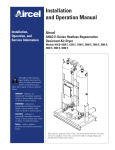
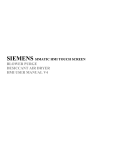
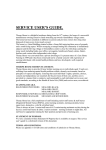

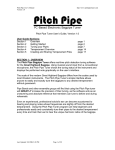

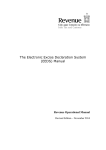
![Electrolux Lux 7000 Bagged Canister Vacuum - C:\Users\Jason&Kim\Desktop\Lux7000[1]](http://vs1.manualzilla.com/store/data/007257175_1-4f8df6fa53bec1c3cae9b6f5e2e6b2de-150x150.png)
